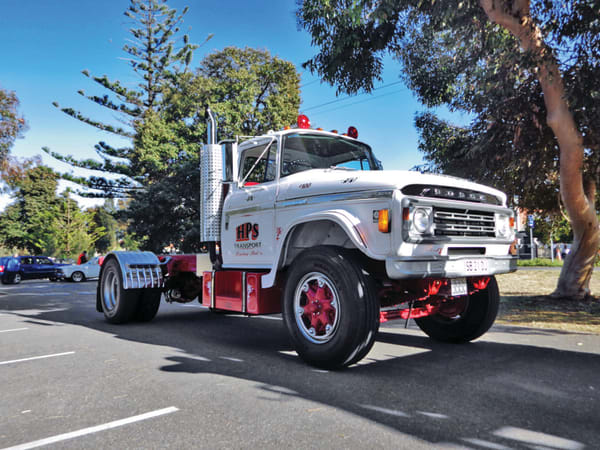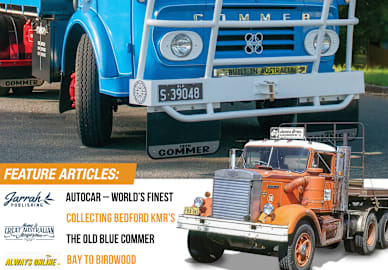In the 1960s, the Australian road transport industry was starting to recognise that the high horsepower/high torque diesel engines being used to move road freight, allowed for quicker and more cost effective transport. The introduction of Peterbilts enabled this realisation, however by the late 1960s, Kenworth had replaced Peterbilt as the frontrunner, furthering the growth of the industry into the 1970s.
Petrol engines continued in use, but “the writing was now on the wall”. Diesel would overtake petrol as the industry moved into the 1970s. On the local market, International Harvester was still a dominant make, but when Chrysler Australia Limited (CAL) released their Dodge AT4 Series, it was recognised that a serious competitor had arrived. In the heavy-duty sector, the AT4 700 Series with its 361cid V8 petrol (202bhp and 330ft/lbs) soon established itself on the highways as a very reliable and hard working interstate truck. Dodge was back!

recipient of the Detroit Diesel 6V53 2 stroke. They were easily identified by the external air intake on the left front mudguard and step tanks.
PICTURE FROM A CAL TRUCK MARKETING BROCHURE 5/1974.
Then, in late 1968, CAL replaced theCummins CF160 6 cylinder diesel with the more powerful Cummins V8 185 ‘VALE’ engine, an engine originating from the joint venture between Chrysler UK and Cummins Engine Company UK, to be the optional diesel for the AT4 700 Series. This engine, on paper, showed a lot of promise with outputs of 185bhp and 329ft/lbs of torque but, soon after its release in Australia, the problems that had dogged this engine in the UK, surfaced.
Truck mechanics that worked on these were soon adept at refitting flywheels that continually broke their mounting bolts, along with cooling fans that lost their blades. Anecdotal comment suggested that, in one case, the flywheel “...shot up through the floor...”. Truck mechanics were certainly earning their money!

this engine made it so easy to replace the V8 and Inline 6 cylinder petrol engines of the time.
PHOTO COURTESY OF PENSKE TRANSPORTATION GROUP INTERNATIONAL
For a period, the 700 Series soldiered on with the Cummins V8 185, but how did the Detroit Diesel option come about? Was it due to the inherent issues with the Cummins or from buyer pressure? According to Mr. John Bain, CAL National Truck Sales Manager at the time, he was approached in the early 1970s, by the Managing Director, Mr. Roger Ryan, of the then Detroit Engine and Tool Company (DETCO), to discuss if CAL could install a Detroit 6V53 into an AT4 700 Series on the production line, on behalf of a Mr. Jack Bennett. Jack had a contract with General Motors Holden (GMH) to transport freight between the GMH plants, and he had a desire to have a GM engine to power his truck, which at the time was an imported International Harvester with a non-GM engine.
As you can imagine, it was a clash of cultures between Chrysler and General Motors, and the reply was as expected, a polite “No”. John Bain did recognise the opportunity though, and a compromise was soon put forward. CAL could supply an AT4-760DV ex the production line, minus the engine but including the Eaton RT510 transmission. His question, “...could DETCO install the 6V53 engine?” It is to be remembered that, during the 1960s/1970s period, repowering of trucks was good business for a number of diesel engine suppliers such as DETCO, and specialist truck workshops around Australia. DETCO had a number of engines that had been used extensively in such engine changes, for instance, its 53 and 71 Series engines.

The bench seat also doubled as the bed when used for interstate applications.
I was employed with Cameron Diesel Service, Belmont, Victoria, in the late 1960s, and repowering was common place, with the late Keith Cameron undertaking this work on behalf of DETCO’s branch in Footscray, and some of his other customers, such as English Livestock Transport of Hamilton. The Detroit 6V53 and the Inline 4-71 were the most popular among transport operators for repowering. Did this fact also influence John Bain at the time, nobody knows but, within a week, the subject truck was delivered to DETCO for ‘prototype’ installation of a 6V53 to be coupled with the Eaton RT510 10 speed transmission driving through to a Q series Rockwell single speed rear axle.
On paper, this was a great specification. During the subsequent road and shake-down test, the package was considered “a gem!”, according to the fitter who did the engine installation. This was echoed by CAL’s Chief Truck Engineer, Mr. George Grotto. The truck now had ten useable gears. There weresome trucks available with 5 speed transmissions and two speed rear axles, but in practice, this did not make ten useable gears; for some it made seven, for others, maybe nine. This was a major plus for this specification.
As is the case when a significant change is made to truck specifications, some teething issues surface that can be easily rectified. In this case, it was a major change of engine from a four stroke to a two stroke cycle design.

This D5N-760DV was used as a prime mover, coupled to a spread axle flat top trailer. The other was a D5N-
760DT tray truck which towed a two axle ‘dog’ trailer.
During the three initial round trips to Melbourne, driven by Jack Bennett, the first issue noted was that the heater failed to deliver warm air into the cab, as the engine did not get to operating temperature and, during the night, he “...froze to death”. This was rectified by soldering up the air bleed holes in the two thermostat housings and changing the radiator assembly over to the one spec’ed for the Cummins engine; although a ‘marginal’ specification with the Cummins, it exceeded the requirements of the Detroit 6V53.
The second issue was the universal joints in the propeller shafts were noisy. By upgrading these from the standard 1480 to 1600 Series joints, the noise was gone.
With diesel engines beginning to make their mark and displace petrol engines in Australia’s transport industry, CAL now had another great specification that it could easily sell against its competitors. Once it became known that you could now get a Dodge 7 Series with a ‘Jimmy’, the orders started to come in.

axle fitted, and the flares are prominently visible.
During March, 1973, the AT4 model was replaced by the D5N Series. While the cab and some front sheet metal was carried over, it was underneath that the D5N had major improvements. The D5N was easily identifiable as it had single headlamps and a single, wide, chrome strip running horizontally along the upper mudguard, and midway across the doors. In the 500/600/700 Series, it now had a locally designed and manufactured new chassis and semi elliptic rear springs without shackles. The chassis had been designed by CAL’s Chief Truck Engineer, George Grotto.
In the D5N-700 Series, the 361cid V8 petrol and the Detroit Diesel 6V53 remained the standard engine, although the Cummins V8 185 was offered in early production as an option. CAL also found that it could now offer individual Bostrom ‘Thinline’ seats, which offered enhanced seating comfort, especially for the driver, as these were of the suspension type. Cab comfort was still not a strong point in the Dodge (or other similar trucks of the era), but the Bostrom seats contributed to this greatly.
The 6V53 Detroit Diesel had two output ratings, as can be seen in the table, but CAL only offered the lower rating of 195bhp in both the 4x2 and 6x4 models, although 216bhp was possible by changing the injectors, which was denoted by the N and H suffix in the engine model identification. I can only guess as to how many AT4 and D5N-700Ds were built with the 6V53, as records are no longer available, but there were about 380 units in 4 x 2 and 6 x 4 models, or approximately 9% of total production.
As John Bain would point out, “The light tare weight of the 700D, and the ability at the time to run at maximum axle loadings, meant that they could move just about as much cargo as a Kenworth but with lower fuel consumption and lower costs point to point, but just not quite as fast”.

Dodges in right-hand drive, that came to Australia. This one has an 8V71 Detroit Diesel engine.
In September, 1977, (build code HJ13) a 10,000lb (4,536kg) front axle would become available as an option to the standard 7,000lb (3,175kg) in the D5N-700 and 690 models. Due to the wider track that these axles had, CAL would add fibreglass flares to the front mudguards to accommodate this, which meant that these Dodge vehicles were very easily identified.
In tandem drive 6 x 4 models, the standard drive was the Rockwell SHHD type rated at 30,000lb. During the build of the D5N-746DT model, a batch (number unknown) was specified, and built with the SLHD drive rated at 34,000lb. Rear suspension was the Hendrickson RT340 walking beam type, used by almost all of the American truck brands that were in Australia at that time. All of these had the Eaton RT610 transmission fitted.
A model not yet mentioned, but available on special order was the D5N 788T, with a Perkins 6/354-2 diesel engine (131bhp and 284lb/ft), coupled with an NP540 (5 speed) main, and a Spicer 7231B (3 speed) auxiliary transmission to SHHD Rockwell rear axles. This model was specifically aimed at the construction industry (concrete agitator) applications. The Series 2 Perkins was the standard diesel option in the 600 models.
The Dodge AT4 and D5N-700D were very popular with both owner operators and fleets alike and, as mentioned, they were very good performers in interstate applications. With the introduction of the 6V53 GM, this enhanced the reputation even further.

forward tilting bonnet. What may have been?
The 53 Series diesel engine was first released in 1957, in both Inline (2, 3, 4, and 6 cylinder) and V configuration (V6, V8, and V12 cylinder). The ‘53’ referred to the displacement of one cylinder, that is 53 cu. inches. Today, the 6V53 is still in production, albeit only for US military applications.
In 1978, CAL ceased truck production as, from 1973, importation of the Mitsubishi FUSO heavy-duty FP/FV103 models was replacing the local heavyduty Dodges, though at some point during the 1970s, CAL had imported four Dodge LV1000 in SKD form, powered by either a Cummins NH250 or a Detroit Diesel 8V71 engine. These were here for quite some time before being assembled. One of these, with a 8V71 Detroit Diesel can be seen in the Transport Hall of Fame, in Alice Springs. Also under consideration during this period, was ‘grafting’ the local cab and the front of the US Dodge LCF (Low Cab Forward) model onto the local D5N chassis and driveline, though with local truck production now ended, and Mitsubishi Motors poised to take over, these projects never eventuated.
*Paul Tol





